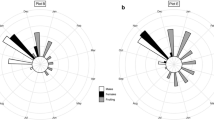Summary
We measured variation in gender among individuals within populations of ragweed (Ambrosia artemisiifolia) in an abandoned old-field and in the greenhouse. There was great variability in sex expression, from all-female to approximately 78% male. Plants differed significantly in gender in different locations within the field. Plants in an area abandoned from agriculture one year previously were more male than plants in a nearby area abandoned four years previously. In the greenhouse, soil moisture treatments and levels of attack by spittlebugs (Philaenus spumarius) did not affect gender. Height was positively correlated with relative maleness in both populations. Plants with greater shoot weight were relatively more male in the greenhouse, but not in the field. The gender variation we observed either has a genetic basis or is controlled by environmental variables other than those we investigated.
Similar content being viewed by others
References
Abul-Fatih HA, Bazzaz FA, Hunt R (1979) The biology of Ambrosia trifida. III. Growth and biomass allocation. New Phytol 83:829–838
Allard HA (1945) Flowering behavior and natural distribution of the eastern ragweeds (Ambrosia) as affected by length of day. Ecology 26:387–394
Austenson HM, Walton PD (1970) Relationships between initial seed weight and mature plant characteristics in spring wheat. Can J Plant Sci 50:53–58
Barker PA, Freeman DC, Harper KT (1982) Variation in the breeding system of Acer grandidentatum. For Sci 28:563–572
Bassett IJ, Crompton CW (1975) The biology of Canadian weeds. 11. Ambrosia artemisiifolia L. and A. psilostachya DC. Can J Plant Sci 55:463–476
Bazzaz FA (1968) Succession on abandoned fields in the Shawnee Hills, southern Illinois. Ecology 49:924–936
Bazzaz FA (1974) Ecophysiology of Ambrosia artemisiifolia: a successional dominant. Ecology 55:112–119
Black JN (1959) Seed size in herbage legumes. Herb Abstr 29:235–241
Charlesworth D, Charlesworth B (1981) Allocation of resources to male and female functions in hermaphrodites. Biol J Linn Soc 15:57–74
Charnov EL (1982) The theory of sex allocation. Princeton University Press, Princeton NJ USA
Freeman DC, Harper KT, Charnov EL (1980) Sex change in plants: old and new observations and new hypotheses. Oecologia (Berlin) 47:222–232
Freeman DC, McArthur ED, Harper KT, Blauer AC (1981) Influence of environment on the floral sex ratio of monoecious plants. Evolution (Lawrence Kans) 35:194–197
Garnock-Jones P (1986) Floret specialisation, seed production, and gender in Artemisia vulgaris (Asteraceae, Anthemideae). Bot J Linn Soc (in press)
Gebben AI (1965) The ecology of common ragweed, Ambrosia artemisiifolia L. in southwestern Michigan. PhD thesis, University Michigan, Ann Arbor MI USA
Halkka O, Raatikainen M, Vasarainen A, Heinonen L (1967) Ecology and ecological genetics of Philaenus spumarius L. (Homoptera). Ann Zool Fenn 4:1–18
Haskins FA, Gorz HJ (1975) Influence of seed size, planting depth, and companion crop on emergence and vigor of seedlings in sweetclover. Agron J 67:652–654
Hendrix SD (1984a) Reactions of Heracleum lanatum to floral herbivory by Depressaria pastinacella. Ecology 65:191–197
Hendrix SD (1984b) Variation in seed weight and its effects on germination in Pastinaca sativa L. (Umbelliferae). Am J Bot 71:795–802
Hendrix SD, Trapp EJ (1981) Plant-herbivore interactions: insect induced changes in host plant sex expression and fecundity. Oecologia (Berlin) 49:119–122
Jones KL (1936) Studies on Ambrosia. I. The inheritance of floral types in the ragweed, Ambrosia elatior. Am Midl Nat 17:673–699
Keever C (1950) Causes of succession on old fields of the Piedmont, North Carolina. Ecol Monogr 20:231–250
Lloyd DG (1980) Sexual strategies in plants. III. A quantitative method for describing the gender of plants. N Z J Bot 18:103–108
Lloyd DG (1984) Gender allocations in outcrossing cosexual plants. In: Dirzo R, Sarukhan J (eds) Perspectives on plant population ecology. Sinauer Associates, Sunderland MA USA, pp 277–300
Lloyd DG, Bawa KS (1984) Modification of the gender of seed plants in varying conditions. Evol Biol 17:255–338
Lovett Doust J (1980) Floral sex ratios in andromonoecious Umbelliferae. New Phytol 85:265–273
Lovett Doust J, Harper JL (1980) The resouce costs of gender and maternal support in an andromonoecious umbellifer, Smyrnium olusatrum L. New Phytol 85:251–264
Payne WW (1963) The morphology of the inflorescence of ragweeds (Ambrosia-Franseria: Compositae). Am J Bot 50:872–880
Pickett STA, Bazzaz FA (1978) Organization of an assemblage of early successional species on a soil moisture gradient. Ecology 59:1248–1255
Primack RB, Lloyd DG (1980) Sexual strategies in plants. IV. The distributions of gender in two monomorphic shrub populations. N Z J Bot 18:109–114
Putnam WL (1953) Notes on the bionomics of some Ontario cercopids (Homoptera). Can Entomol 85:244–248
Raynal DJ, Bazzaz FA (1975) Interference of winter annuals with Ambrosia artemisiifolia in early successional fields. Ecology 56:35–49
Ross MD, Gregorius H-R (1983) Outcrossing and sex function in hermaphrodites: a resource-allocation model. Am Nat 121:204–222
Schaal BA (1980) Reproductive capacity and seed size in Lupinus texensis. Am J Bot 67:703–709
Stanton ML (1984) Seed variation in wild radish: effect of seed size on components of seedling and adult fitness. Ecology 65:1105–1112
Weaver CR, King DR (1954) The meadow spittlebug. Ohio Agric Exp Stn Res Bull 741:1–99
Whitham TG, Mopper S (1985) Chronic herbivory: impacts on architecture and sex expression of pinyon pine. Science 228:1089–1091
Willson MF, Ruppel KP (1984) Resource allocation and floral sex ratios in Zizania aquatica. Can J Bot 62:799–805
Zimmerman JK, Weis IM (1983) Fruit size variation and its effects on germination and seedling growth in Xanthium strumarium. Can J Bot 61:2309–2315
Author information
Authors and Affiliations
Rights and permissions
About this article
Cite this article
McKone, M.J., Tonkyn, D.W. Intrapopulation gender variation in common ragweed (Asteraceae: Ambrosia artemisiifolia L.), a monoecious, annual herb. Oecologia 70, 63–67 (1986). https://doi.org/10.1007/BF00377111
Received:
Issue Date:
DOI: https://doi.org/10.1007/BF00377111




